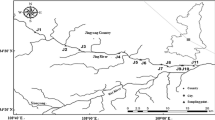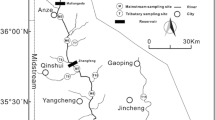Abstract
Identification and quantification of sources of nitrate (NO3–) in freshwater lakes provide useful information for management of eutrophication and improving water quality in lakes. Dual δ15N- and δ18O-NO3– isotopes and a Bayesian isotope mixing model were applied to identify sources of NO3– and estimate their proportional contributions to concentrations of NO3– in Tai Lake, China. In waters of Tai Lake, values for δ15N-NO3– ranged from 3.8 to 10.1‰, while values of δ18O ranged from 2.2 to 12.0‰. These results indicated that NO3– was derived primarily from agricultural and industrial sources. Stable isotope analysis in R called SIAR model was used to estimate proportional contributions from four potential NO3– sources (agricultural, industrial effluents, domestic sewage, and rainwater). SIAR output revealed that agricultural runoff provided the greatest proportion (50.8%) of NO3– to the lake, followed by industrial effluents (33.9%), rainwater (8.4%), and domestic sewage (6.8%). Contributions of those primary sources of NO3– to sub-regions of Tai Lake varied significantly (p < 0.05). For the northern region of the lake, industrial source (35.4%) contributed the greatest proportion of NO3–, followed by agricultural runoff (27.4%), domestic sewage (21.3%), and rainwater (15.9%). Whereas for the southern region, the proportion of NO3– contributed from agriculture (38.6%) was slightly greater than that contributed by industry (30.8%), which was similar to results for nearby inflow tributaries. Thus, to improve water quality by addressing eutrophication and reduce primary production of phytoplankton, NO3– from both nonpoint agricultural sources and industrial point sources should be mitigated.

ᅟ






Similar content being viewed by others
References
Burns DA, Boyer EW, Elliott EM, Kendall C (2009) Sources and transformations of nitrate from streams draining varying land uses: evidence from dual isotope analysis. J Environ Qual 38:1149–1159
Carpenter SR (2005) Eutrophication of aquatic ecosystems: bistability and soil phosphorus. Proc Natl Acad Sci U S A 102:10002–10005
Chen M, Zeng G, Zhang J, Xu P, Chen A, Lu L (2015) Global landscape of total organic carbon, nitrogen and phosphorus in lake water. Sci Rep 5:15043
Chen X, Yang L, Xiao L, Miao A, Xi B (2012a) Nitrogen removal by denitrification during cyanobacterial bloom in Lake Taihu. J Freshw Ecol 27:243–258
Chen Z-X, Yu L, Liu W-G, Lam MH, Liu G-J, Yin X-B (2014) Nitrogen and oxygen isotopic compositions of water-soluble nitrate in Taihu Lake water system, China: implication for nitrate sources and biogeochemical process. Environ Earth Sci 71:217–223
Chen ZX, Liu G, Liu WG, Lam MH, Liu GJ, Yin XB (2012b) Identification of nitrate sources in Taihu Lake and its major inflow rivers in China, using δ15N-NO3 − and δ18O-NO3 − values. Water Sci Technol 66:536
Davis P, Syme J, Heikoop J, Fessenden-Rahn J, Perkins G, Newman B et al (2015) Quantifying uncertainty in stable isotope mixing models. J Geophys Res: Biogeosci 120:903–923
Deutsch B, Mewes M, Liskow I, Voss M (2006) Quantification of diffuse nitrate inputs into a small river system using stable isotopes of oxygen and nitrogen in nitrate. Org Geochem 37:1333–1342
Ding J., Xi B., Gao R., He L., Liu H., Dai X., et al., 2014. Identifying diffused nitrate sources in a stream in an agricultural field using a dual isotopic approach. Sci. Total Environ 484: 10
Divers MT, Elliott EM, Bain DJ (2014) Quantification of nitrate sources to an urban stream using dual nitrate isotopes. Environ Sci Technol. 48:10580–10587
Feng W, Zhu Y, Wu F, He Z, Zhang C, Giesy JP (2016) Forms and lability of phosphorus in algae and aquatic macrophytes characterized by solution 31P NMR coupled with enzymatic hydrolysis. Sci Rep 6:37164
Fry B (2003) Steady state models of stable isotopic distributions. Isot Environ Healt S 39:219
Fukada T, Hiscock KM, Dennis PF, Grischek T (2003) A dual isotope approach to identify denitrification in groundwater at a river-bank infiltration site. Water Res 37:3070
Griffin TS, Honeycutt CW, He Z (2002) Effects of temperature, soil water status, and soil type on swine slurry nitrogen transformations. Biol Fert Soils 36:442–446
He ZQ, Senwo ZN, Zou HX, Tazisong IA, Martens DA (2014) Amino compounds in poultry litter,litter-amended pasture soils and grass shoots. Pedosphere 24:178–185
Ji X, Xie R, Hao Y, Lu J (2017) Quantitative identification of nitrate pollution sources and uncertainty analysis based on dual isotope approach in an agricultural watershed. Environ Pollut 229:586
Kaushal SS, Groffman PM, Band LE, Elliott EM, Shields CA, Kendall C (2011) Tracking nonpoint source nitrogen pollution in human-impacted watersheds. Environ Sci Technol 45:8225–8232
Kendall C, Elliott EM, Wankel SD (2007) Tracing anthropogenic inputs of nitrogen to ecosystems. In: Michener R, Lajtha K (eds) Stable isotopes in ecology and environmental science. Blackwell Publishing Ltd, Oxford, pp 375–449
Kim K-H, Yun S-T, Mayer B, Lee J-H, Kim T-S, Kim H-K (2015) Quantification of nitrate sources in groundwater using hydrochemical and dual isotopic data combined with a Bayesian mixing model. Agric Ecosyst Environ 199:369–381
Li SL, Liu CQ, Li J, Liu X, Chetelat B, Wang B et al (2010) Assessment of the sources of nitrate in the Changjiang River, China using a nitrogen and oxygen isotopic approach. Environ Sci Technol 44:1573–1578
Liu CQ, Li SL, Lang YC, Xiao HY (2006) Using delta15N- and delta18O-values to identify nitrate sources in karst ground water, Guiyang, Southwest China. Environ. Sci. Technol. 40:6928
Liu S, Zhu Y, Wu F, Meng W, He Z, Giesy JP (2016) Characterization of plant-derived carbon and phosphorus in lakes by sequential fractionation and NMR spectroscopy. Sci Total Environ 566:1398–1409
Liu S, Zhu Y, Wu F, Meng W, Wang H, He Z et al (2017) Using solid 13C NMR coupled with solution 31P NMR spectroscopy to investigate molecular species and lability of organic carbon and phosphorus from aquatic plants in Tai Lake. China Environ Sci Pollut Res 24:1880–1889
Lockhart K, Harter T, Grote M, Young MB, Eppich G, Deinhart A et al (2014) Bayesian nitrate source apportionment to individual groundwater wells in the Central Valley by use of nitrogen, oxygen, and boron isotopic tracers. Water Resour Res 52:5577–5597
Mayer B, Boyer EW, Goodale C, Jaworski NA, Nvan B, Howarth RW et al (2002) Sources of nitrate in rivers draining sixteen watersheds in the northeastern U.S.: isotopic constraints. Biogeochemistry 57-58:171–197
Mccarthy MJ, Lavrentyev PJ, Yang L, Zhang L, Chen Y, Qin B et al (2007) Nitrogen dynamics and microbial food web structure during a summer cyanobacterial bloom in a subtropical, shallow, well-mixed, eutrophic lake (Lake Taihu, China). Hydrobiologia 581:195–207
Moore JW, Semmens BX (2008) Incorporating uncertainty and prior information into stable isotope mixing models. Ecol Lett 11:470–480
Nestler A, Berglund M, Accoe F, Duta S, Xue D, Boeckx P et al (2011) Isotopes for improved management of nitrate pollution in aqueous resources: review of surface water field studies. Environ Sci Pollut R 18:519–533
Pardo LH, Kendall C, Pett-Ridge J, Chang CCY (2004) Evaluating the source of streamwater nitrate using δ15N and δ18O in nitrate in two watersheds in New Hampshire. USA Hydrol Process 18:2699–2712
Parnell AC, Inger R, Bearhop S, Jackson AL (2010) Source partitioning using stable isotopes: coping with too much variation. PLoS One 5:e9672
Parnell AC, Phillips DL, Bearhop S, Semmens BX, Ward EJ, Moore JW et al (2013) Bayesian stable isotope mixing models. Environmetrics 24:387–399
Phillips DL, Newsome SD, Gregg JW (2005) Combining sources in stable isotope mixing models: alternative methods. Oecologia 144:520–527
Phillipsdonald L., IngerRichard, BearhopStuart, Jacksonandrew L., Moorejonathan W., Parnellandrew C., et al., 2014. Best practices for use of stable isotope mixing models in food-web stu. Can. J Zool 92
Qin B, Liu Z, Havens K (2007) Eutrophication of shallow lakes with special reference to Lake Taihu. Springer Netherlands, China
Rivett MO, Buss SR, Morgan P, Smith JW, Bemment CD (2008) Nitrate attenuation in groundwater: a review of biogeochemical controlling processes. Water Res 42:4215–4232
Shi YD, Mao XW (2013) Hydrologic annual report in Taihu Lake basin in 2011. pp. 3
Silva SR, Kendall C, Wilkison DH, Ziegler AC, Chang CCY, Avanzino RJ (2000) A new method for collection of nitrate from fresh water and the analysis of nitrogen and oxygen isotope ratios. J Hydrol 228:22–36
Townsend-Small A, McCarthy MJ, Brandes JA, Yang L, Zhang L, Gardner WS (2007) Stable isotopic composition of nitrate in Lake Taihu, China, and major inflow rivers. Hydrobiologia 581:135–140
Vitousek PM, Aber JD, Howarth RW, Likens GE, Matson PA, Schindler DW et al (1997) Human alteration of the global nitrogen cycle: sources and consequences. Ecol Appl 7:737–750
Voss M, Deutsch B, Elmgren R, Humborg C (2006) River biogeochemistry and source identification of nitrate by means of isotopic tracers in the Baltic Sea catchments. Biogeosciences 3:663–676
Wankel SD, Kendall C, Francis CA, Paytan A (2006) Nitrogen sources and cycling in the San Francisco Bay estuary: a nitrate dual isotopic composition approach. Limnol Oceanogr 51:1654–1664
Xing M, Liu W (2016) Using dual isotopes to identify sources and transformations of nitrogen in water catchments with different land uses, Loess Plateau of China. Environ Sci Pollut Res Int 23:388–401
Xue D, Baets BD, Cleemput OV, Hennessy C, Berglund M, Boeckx P (2012) Use of a Bayesian isotope mixing model to estimate proportional contributions of multiple nitrate sources in surface water. Environ Pollut 161:43–49
Xue D, Botte J, De BB, Accoe F, Nestler A, Taylor P et al (2009) Present limitations and future prospects of stable isotope methods for nitrate source identification in surface- and groundwater. Water Res 43:1159–1170
Yi Q, Chen Q, Hu L, Shi W (2017) Tracking nitrogen sources, transformation, and transport at a basin scale with complex plain river networks. Environ Sci Technol 51:5396
Yu L, Zhu J, Mulder J, Dörsch P (2016) Multiyear dual nitrate isotope signatures suggest that N-saturated subtropical forested catchments can act as robust N sinks. Glob Chang Biol 22:3662–3674
Zhu Y, Wu F, He Z (2015) Bioavailability and preservation of organic phosphorus in freshwater sediments and its role in lake eutrophication. In: He Z, Wu F, editors. Labile organic matter-chemical compositions, function, and significance in soil and the environment. SSSA Spec Publ 62, Madison, WI: Soil Sci. Soc. Am. pp. 275–294
Zong Z, Wang X, Tian C, Chen Y, Fang Y, Zhang F et al (2017) First assessment of NOx sources at a regional background site in North China using isotopic analysis linked with modeling. Environ Sci Technol 51:5923–5931
Funding
The work was supported in part by the National Natural Science Foundation of China (Nos. 41807372, 41630645, 41603113, and 41573126) and China Postdoctoral Science Foundation (2017M622280 and 2016M591227).
Author information
Authors and Affiliations
Corresponding author
Ethics declarations
Conflict of interest
The authors declare that they have no conflict of interest.
Additional information
Responsible editor: Philippe Garrigues
Highlights
1. Dual isotopes and a Bayesian mixing model were applied to identify NO3– sources.
2. Agriculture and industry are main contributors to NO3– sources in Tai Lake.
3. Industrial source (35.4%) was the largest nitrate contributor to northern lake.
4. Agricultural source (38.6%) was the largest nitrate contributor to southern lake.
5. The results will help evaluate remediation efforts and strategies in the region.
Rights and permissions
About this article
Cite this article
Liu, S., Wu, F., Feng, W. et al. Using dual isotopes and a Bayesian isotope mixing model to evaluate sources of nitrate of Tai Lake, China. Environ Sci Pollut Res 25, 32631–32639 (2018). https://doi.org/10.1007/s11356-018-3242-1
Received:
Accepted:
Published:
Issue Date:
DOI: https://doi.org/10.1007/s11356-018-3242-1




